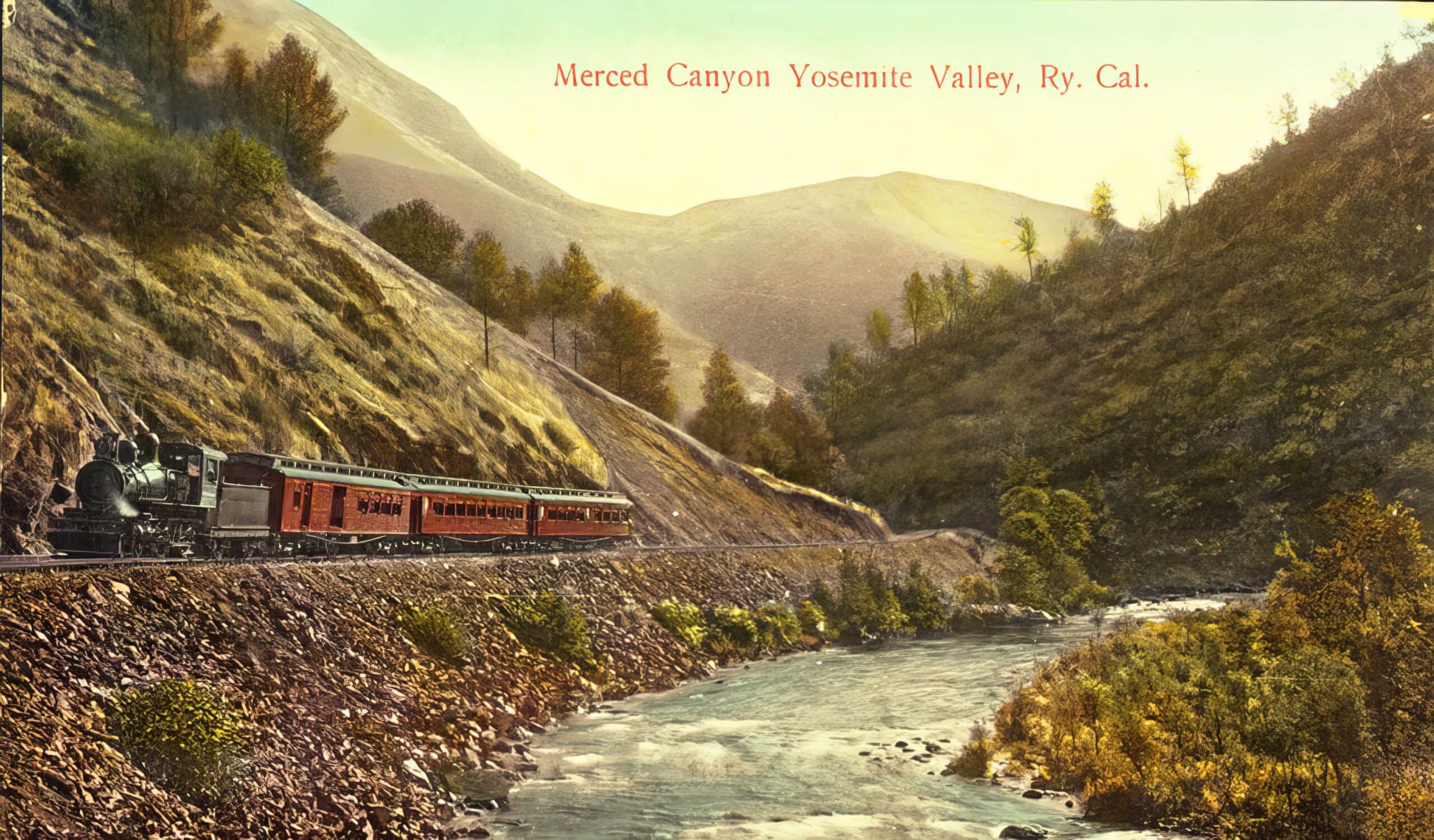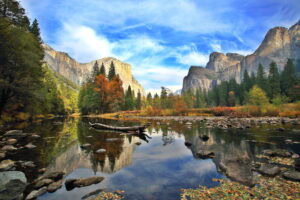Today, traveling through Yosemite Mariposa County along all-season Highway 140 is an ooh-and-awesome drive. As your vehicle banks into the gentle curves along the Wild & Scenic Merced River Canyon, steal a glance over your shoulder. The graded dirt path visible just across the Merced between Briceburg and El Portal is how early tourists made their intrepid journey to see America’s newest and most stunning national park in the first half of the 1900s, via the Yosemite Valley Railroad.
New National Park, Birth of a Railroad
Let’s start with the historic backstory. An Act of Congress designated Yosemite National Park on October 1, 1890, making it the third national park in the United States, after Yellowstone (1872) and Sequoia (1890).
With the swipe of the legislative quill, the notion of national park tourism was born. The only issue was getting there. Traveling to Yosemite in the Park’s early era required literal horsepower via rickety wagon and stagecoach passage, and a bit later, unreliable automobiles – unless you were John Muir and walked there. Bottom line, visiting Yosemite took expedition-level intent.
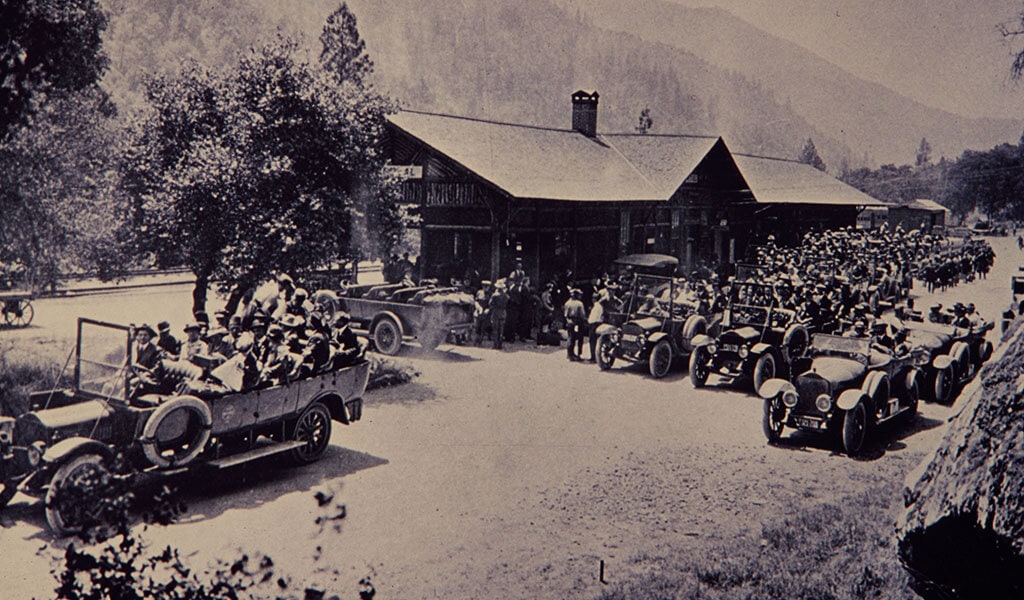
As with any new venture, the National Park idea required infrastructure. A railroad through the Merced River Canyon from Merced was the answer to the challenging journey, and the Yosemite Valley Railroad was born. The 77-mile short line was promptly completed, and between 1907 and 1945, the Yosemite Valley Railroad enabled many to witness the Park’s fabled majesty for the very first time.
Game changer! Now it was possible to take a marvelous train ride from the fledgling San Joaquin Valley city of Merced to El Portal to visit Yosemite National Park. Rather than endure dusty roads and balky automobiles, folks could relax in plush Pullman sleeper cars or recline on the deck of a beautiful observation car. The new Yosemite Valley Railroad inspired giddy vacation vibes as it chugged up the oak-studded flank of the western Sierra range along the mighty Merced River towards nature’s cathedral of granite up ahead.
While the original intent of the railroad was to provide passenger service to the Park, commercial interests supported the growth of freight traffic. In 1910, the Yosemite Lumber Company was formed and purchased 10,000 forest acres on the south side of the Merced River opposite El Portal.
Tens of thousands of passengers (along with timber, mining products, and miscellaneous freight) rode to Yosemite National Park on the new rail line. Passenger business peaked in the mid-1920s. By then, the use of private automobiles accelerated and when all-season Highway 140 was completed in 1926, passenger numbers on the Yosemite Valley Railroad, well, went off the proverbial rails. Passenger and freight service continued until August 1945, when the Yosemite Valley Railroad made its last scheduled run.
Today’s chief historic conductor is Jack Burgess, the noted rail authority and driving force behind the Yosemite Valley Railroad website. For a deep dive into the railroad’s legacy and lore, see Tracing the Yosemite Valley Railroad Today. And for his amazing handmade scale model of the Yosemite Valley Railroad line, check out the video.
Towns, Trails and Trains Today
Today, there are still plenty of touchstones in Yosemite Mariposa County that harken back to those early, pre-highway days when a train whistle was the soundtrack for travel to the Park.
El Portal
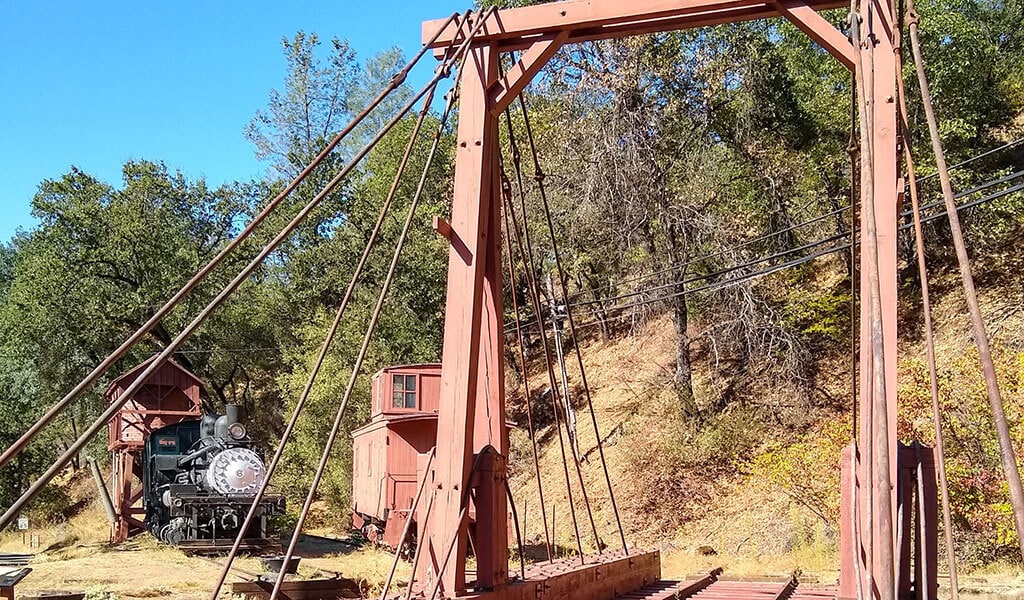
The town of El Portal served as the end of the line for the Yosemite Valley Railroad. Passengers would ride the rails to the beautiful wooden station there, disembark, and board four-wheeled modes of transportation to continue their trip on to Yosemite Valley.
Carefully restored equipment and buildings from those railroading days are on display in El Portal. Just a few yards west of the El Portal Market and gas station, turn north onto El Portal Road to find Yosemite Valley Railroad treasure.
Excellent interpretive signs tell the story of the Yosemite Valley Railroad. Many of the historic structures at El Portal were originally from Bagby, and moved in 1966 before the town was covered by water with the expansion of Lake McClure behind the New Exchequer Dam.
The person-powered turntable is a detailed reconstruction of the original on the same foundation as when the line began service in ‘07. The railroad’s turntable served the important function of reversing the main engine and car for the return trip down the Merced River Canyon. Thanks to a Yosemite Conservancy-funded project, the turntable and caboose were brought back to life using original engineering drawings and historic photographs. The turntable is fully functional, and a few people can team up to move it by hand.
Look to the left to see Yosemite Valley Railroad caboose #15 and the Hetch Hetchy Railroad #6 engine, which operated in the steep terrain just north of Yosemite Valley during the construction of the Hetch Hetchy Dam.
Merced River Trail
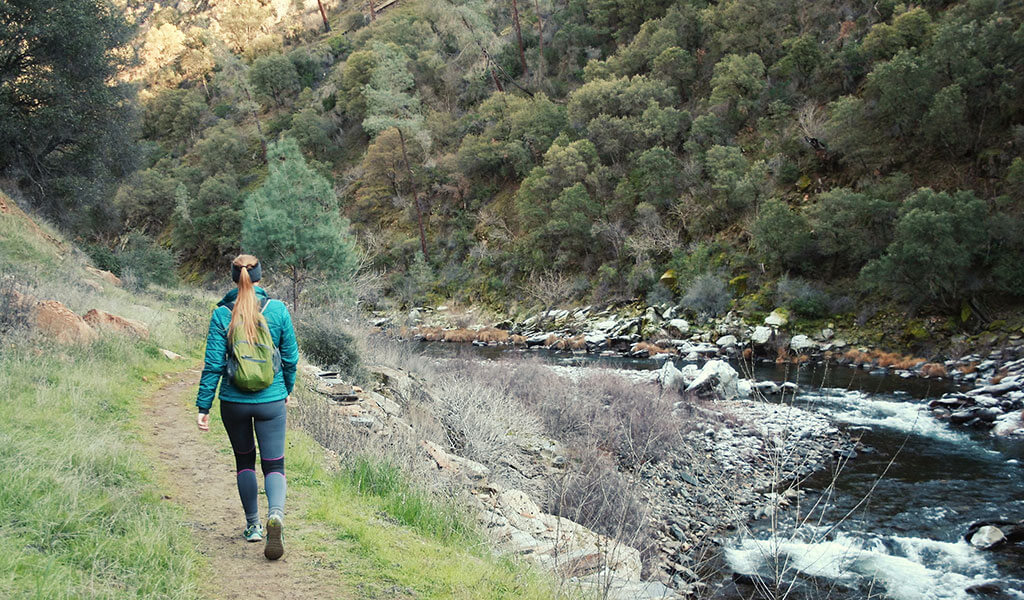
A stretch of the Yosemite Valley Railroad’s original rail bed is now wonderfully repurposed as the fun, 5.5-mile Merced River Trail. The trail is dog-friendly (on leash) and with a gentle grade, is also great for kids. Spring wildflowers and the ever-present sound of flowing water provide wonderful company along the way. Note: in the warmer months, bring a hat, sunscreen and plenty of water, as there is little shade along the way. The trail is also not complete past the temporary bridges that cross the Merced River near Savage’s Trading Post, so be prepared for the out-and-back trail from Briceburg.
Merced Falls Station
Named for a set of rapids on the Merced River, Merced Falls was one of the Yosemite Valley Railroad’s bustling stations focused on commerce. Local lumber mills were the focus for freight conveyance in and out of the station. A pair of sawmills in Merced Falls cut wood for the Yosemite Sugar Pine Lumber Company, which shipped lumber down from the Sierra Nevada on the Yosemite Valley Railroad.
With the construction of the Central Pacific Railroad across California’s Great Central Valley, many towns including Merced Falls that were not on the new rail line fell into disrepair. The rapids themselves were inundated by McSwain Dam, built across the Merced River in the 1960s. Rail buffs will find the YVR ruins present in Merced Falls of interest, but they do require exploring and imagination!
Bagby
Located just below the Wild & Scenic Merced River at the inlet of Lake McClure, the historic town of Bagby was an important station stop on the Yosemite Valley Railroad. Named for local hotel owner Benjamin Bagby, it was a bustling mining town during the California Gold Rush. Today the Bagby Campground & Recreation Area is a great place to enjoy the beauty of Yosemite Mariposa County and the Merced River, to swim, hike, bike and camp.
While Lake McClure now covers Bagby for most of the year, during low-water years the lake level drops to reveal the town’s footprint, foundations and other ruins. Take a look at the video below for a deeper dive into this “underwater ghost town.”
Yosemite Mountain Sugar Pine Railroad
The Yosemite Mountain Sugar Pine Railroad is a historic excursion located near the Park’s South Gate at Fish Camp. Ride the authentic vintage steam engine locomotives that chug along the narrow gauge right-of-way of the Madera Sugar Pine Lumber Company through the Sierra National Forest. Tours are seasonal and operate April through November.
During logging days of yore, there were more than 140 miles of narrow-gauge track spread over the central Sierra Nevada. There was also a 54-mile flume that sent lumber to Madera where it was distributed to a worldwide market. The on-site Thornberry Museum presents the railroad’s history and local logging legacy with interesting artifacts and exhibits.
Note: the remains of the flume still stand running down from Fish Camp to Madera throughout areas of Madera County near Oakhurst and Bass Lake. However, these areas are privately owned and fenced off in many locations. Please respect barriers and private property.
Railtown 1897 State Historic Park
Located in Jamestown (50 miles north of Mariposa on Highway 49), Railtown 1897 State Historic Park is a popular place to engage with California’s rich railroad heritage and take a historic train ride. Weekends April to October, visitors enjoy a six-mile, 45-minute roundtrip steam train excursion through scenic Sierra foothills.
Known as “The Movie Railroad,” Railtown 1897 continues as a popular Hollywood location site – its historic locomotives and railroad cars have more than 200 film, TV, and commercial credits. Railtown 1897’s most famous locomotive, “Movie Star” No. 3, might be the Tom Hanks of trains for all its screen gems!
Railtown 1897 State Historic Park is open daily except for Thanksgiving, Christmas, and New Year’s Day.
All Aboard!
Feeling the lure of the rails? Train travel is a throwback, highly relaxing way to go. Amtrak offers connecting service to Yosemite National Park via the San Joaquins line. From NorCal and SoCal cities, book your trip to Merced; from there, connect to the Yosemite Area Regional Transit System (YARTS) bus. YARTS service continues from Merced along Highway 140 with stops in Mariposa, Midpines, and El Portal on its way to Yosemite National Park.
To explore lodging options, things to do and places to eat, visit Yosemite.com, the #1 trip planning site for vacations to Yosemite National Park and historic Mariposa County. To stay up to date, follow @YosemiteNation on social media and subscribe to our newsletter, “The Wanderer”. Be sure to subscribe to our YouTube channel for great videos on the people and places of Yosemite Mariposa County.

